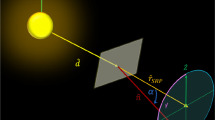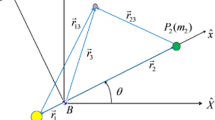Abstract
The set of the orbital angular-momentum reversal, or H-reversal, sailcraft trajectory was born as a type of unconventional precursor interstellar mission trajectory by using highperformance solar sails. Starting from an outline of the H-reversal sail trajectory, this paper mainly focuses on the 2D reversal-mode solution to the general solar-photon sail motion equations. The feasible region for H-reversal trajectories in fixed sail attitude angles is illustrated. Some interesting applications of the H-reversal trajectory are presented in detail to show its advantages. As a special case, a precursor interstellar probe can be delivered with a constant sail orientation in the H-reversal trajectory to be compared with the direct-motion sail flyby of the Sun. Of importance are the heliocentric periodic orbits in double H-reversal modes, obtained via both fixed and time-varying sail attitude angles. Two more applications involving H-reversal trajectories are discussed in terms of asteroid deflection and transfer trajectory to rectilinear orbits. Finally, some items of the mathematics behind the 3D motion-reversal trajectories are summarized.
Similar content being viewed by others
Change history
11 February 2022
A Correction to this paper has been published: https://doi.org/10.1007/s42064-022-0136-2
References
Macdonald, M., McInnes, C., Hughes, G. Technology requirements of exploration beyond Neptune by solar sail propulsion. Journal of Spacecraft and Rockets, 2010, 47(3): 472–483.
Lyngvi, A., Falkner, P., Peacock, A. The interstellar heliopause probe technology reference study. Advances in Space Research, 2005, 35(12): 2073–2077.
Sauer, C. G. Jr. Solar sail trajectories for solar polar and interstellar probe missions. In: Proceedings of the AAS/AIAA Astrodynamics Specialist Conference, 1999, 547–562.
Johnson, L., Leifer, S. Propulsion options for interstellar exploration. In: Proceedings of the 36th AIAA/ASME/SAE/ASEE Joint Propulsion Conference and Exhibit, 2000.
Matloff, G. L., Vulpetti, G., Bangs, C., Haggerty, R. The interstellar probe (ISP): Pre-perihelion trajectories and application of holography. NASA/CR-2002-211730, NASA Marshall Space Flight Center, 2002.
Macdonald, M., McInnes, C. R. Solar sail mission applications and future advancement. In: Proceedings of the 2nd International Symposium on Solar Sailing, 2010.
McInnes, C. R. Solar sailing: technology, dynamics, and mission applications. Springer, 1999.
Leipold, M., Wagner, O. ‘Solar photonic assist’ trajectory design for solar sail missions to the outer solar system and beyond. In: Proceedings of the AAS/GSFC International Symposium on Space Flight Dynamics, 1998.
Dachwald, B. Optimal solar-sail trajectories for missions to the outer solar system. Journal of Guidance, Control, and Dynamics, 2005, 28(6): 1187–1193.
Zeng, X. Y., Li, J. F., Baoyin, H. X., Gong, S. P. Trajectory optimization and applications using high performance solar sails. Theoretical and Applied Mechanics Letters, 2011, 1(3): 033001.
Vulpetti, G. Missions to the heliopause and beyond by staged propulsion spacecrafts. In: Proceedings of the 43rd World Space Congress, 1992.
Vulpetti, G. Sailcraft at high speed by orbital angular momentum reversal. Acta Astronautica, 1997, 40(10): 733–758.
Vulpetti, G. 3D high-speed escape heliocentric trajectories by all-metallic-sail low-mass sailcraft. Acta Astronautica, 1996, 39(1–4): 161–170.
Vulpetti, G. General 3D H-reversal trajectories for highspeed sailcraft. Acta Astronautica, 1999, 44(1): 67–73.
Vulpetti, G. Fast solar sailing: astrodynamics of special sailcraft trajectories. Springer, 2013.
Dandouras, I., Pirard, B., Prado J. Y. High performance solar sails for linear trajectories and heliostationary missions. Advances in Space Research, 2004, 34(1): 198–203.
Zeng, X. Y., Baoyin, H. X., Li, J. F., Gong, S. P. Feasibility analysis of the angular momentum reversal trajectory via hodograph method for high performance solar sails. Science China Technological Sciences, 2011, 54(11): 2951–2957.
Zeng, X. Y., Baoyin, H. X., Li, J. F., Gong, S. P. A solar sail inverse periodic orbit. Journal of Tsinghua University (Science and Technology), 2012, 52(1): 118–121. (in Chinese)
Zeng, X. Y., Baoyin, H. X., Li, J. F., Gong S. P. New applications of the H-reversal trajectory using solar sails. Research in Astronomy and Astrophysics, 2011, 11(7): 863–878.
Pino, T., Circi, C. A star-photon sailcraft mission in the Alpha Centauri System. Advances in Space Research, 2017, 59(9): 2389–2397.
Bruno, C., Matloff, G. Key technologies to enable nearterm interstellar scientific precursor missions. China Aerospace Publishing House, 2013. (in Chinese)
Quarta, A. A., Mengali, G. Solar sail capabilities to reach elliptic rectilinear orbits. Journal of Guidance, Control, and Dynamic, 2011, 34(3): 923–927.
Jiang, F. H., Baoyin, H. X., Li, J. F. Practical techniques for low-thrust trajectory optimization with homotopic approach. Journal of Guidance, Control, and Dynamics, 2012, 35(1): 245–258.
Pan, B. F., Lu, P., Pan, X., Ma, Y. Y. Double-homotopy method for solving optimal control problems. Journal of Guidance, Control, and Dynamics, 2016, 39(8): 1706–1720.
Zeng, X. Y., Alfriend, K. T., Li, J. F., Vadali, S. R. Optimal solar sail trajectory analysis for interstellar missions. The Journal of the Astronautical Sciences, 2012, 59(3): 502–516.
Wie, B. Sail flatness, attitude, and orbit control issues for an ST-7 solar sail spacecraft. In: Proceedings of the Solar Sail Technical Interchange Meeting, 2001.
Vulpetti, G. Reaching extra-solar-system targets via large post-perihelion lightness-jumping sailcraft. Acta Astronautica, 2011, 68(5–6): 636–643.
Zeng, X. Y., Alfriend, K. T., Vadali, S. R., Baoyin, H. X., Gong, S. P. Time-optimal trajectory design for a dualsatellite sailcraft interstellar mission with probe release (AAS 13–221). In: Proceedings of the 23rd Spaceflight Mechanics Meeting, 2013.
Mengali, G., Quarta, A. A., Romagnoli, D., Circi, C. H2-reversal trajectory: a new mission application for highperformance solar sails. Advances in Space Research, 2011, 48(11): 1763–1777.
Zeng, X. Y., Baoyin, H. X., Li, J. F., Gong, S. P. Threedimensional time optimal double angular momentum reversal trajectory using solar sails. Celestial Mechanics and Dynamical Astronomy, 2011, 111(4): 415–430.
Zeng, X. Y., Alfriend, K. T., Vadali, S. R. Solar sail planar multireversal periodic orbits. Journal of Guidance, Control, and Dynamics, 2014, 37(2): 674–681.
Gong, S. P., Li, J. F., Zeng, X. Y. Utilization of an Hreversal trajectory of a solar sail for asteroid deflection. Research in Astronomy and Astrophysics, 2011, 11(10): 1123–1133.
Zeng, X. Y., Gong S. P., Li J. F., Alfriend K. T. Solar sail body-fixed hovering over elongated asteroids. Journal of Guidance, Control, and Dynamics, 2016, 39(6): 1223–1231.
Pitz, A., Kaplinger, B., Vardaxis, G., Winkler, T., Wie, B. Conceptual design of a hypervelocity asteroid intercept vehicle (HAIV) and its flight validation mission. Acta Astronautica, 2014, 94(1): 42–56.
Vardaxis, G., Wie, B. Impact risk analysis of Near-Earth asteroids with multiple successive Earth encounters. In: Proceedings of the AAS/AIAA Space Flight Mechanics Meeting, 2016.
Zeng, X. Y., Gong, S. P., Li, J. F. Earth-crossing asteroid intercept mission with a solar sail spacecraft. IEEE Aerospace and Electronic Systems Magazine, 2014, 29(10): 4–15.
Wright, J. L. Space sailing. Gordon and Breach Science Publishers, 1993.
Roy, A. E. Orbital motion. In: Proceedings of the Institute of Physics Publishing, 2005, 87–89.
Colombo, G., Lautman, D. A., Pettengill, G. An alternative option to the dual-probe out-of-ecliptic mission via Jupiter swingby. In: Proceedings of the Symposium on the Study of the Sun and Interplanetary Medium in Three Dimensions, 1976, 37–47.
Quarta, A. A., Mengali, G. Optimal solar sail transfer to linear trajectories. Acta Astronautica, 2013, 82(2): 189–196.
Vulpetti, G. Sailcraft-based mission to the Solar Gravitational Lens. In: Proceedings of the AIP Conference Proceedings, 2000, 504(1): 968–973.
Acknowledgements
This work was supported by the National Natural Science Foundation of China (No. 11602019) and the Young Elite Scientist Sponsorship Program by CAST (2016QNRC001). The Excellent Young Teachers Program of Beijing Institute of Technology (2015YG0605) is acknowledged as well.
Author information
Authors and Affiliations
Corresponding author
Additional information
Xiangyuan Zeng is an associate professor in the School of Automation, Beijing Institute of Technology. He received his Ph.D. degree of Mechanics from Tsinghua University, in 2013, and worked there as a postdoctor until 2015. He was ever a visiting scholar of Texas A&M University from 2011 to 2012, and a visiting professor in Sapienza University of Rome, in 2018, supported by the Young Elite Scientist Sponsorship Program by CAST (YESS). His current research interests are astrodynamics near asteroids, surface dynamics and bionic robots for surface explorations.
Giovanni Vulpetti has received his M.S. and Ph.D. degrees, in 1969 and 1973, respectively. He specialized in astrodynamics, and wrote many tens of scientific papers about interstellar flight, astrodynamics and propulsion concepts, in particular the matterantimatter annihilation propulsion. In 1979, he joined Telespazio SpA in Italy. From 1995 to 2013, he has been a member of the IAA committee for Lunar Base & Mars exploration. In 2001, he was a consultant at NASA/MSFC for studying the astrodynamics of NASA Interstellar Probe. He has implemented large computer codes for mission analysis and trajectory optimization via rockets and solar-sails. In 1990s, he contributed to the IAA committee for small satellites. As an application, he proposed and got the approval from Telespazio’s CEO for the Telespazio’s micro-satellite named TEMISAT, which launched in 1993, from the base Plesetsk in Russia. From 2006 to 2007, he worked for the company Galilean Plus S.r.l. in Italy as the chief scientist, where he contributed to the program of the Italian Space Agency. After that, he served as the guest managing editor of Acta Astronautica, in 2009 and 2014, respectively. Since 2013, he has been a senior guest lecturer at the Department of Astronautical Engineering of the Sapienza University of Rome. Since 1994, he has been a full member of the International Academy of Astronautics in France.
Christian Circi is currently an assistant professor in flight mechanics at the Department of Astronautical, Electrical and Energy Engineering, Sapienza University of Rome. He got his M.S. degrees in aeronautical engineering and aerospace engineering, and pursued his Ph.D. degree in aerospace engineering at Sapienza University of Rome. He worked as a researcher at the Grupo de Mecanica of Vuelo-Madrid (GMV), and a research assistant at the Department of Aerospace Engineering. He is a lecturer in “Interplanetary Trajectories” and “Flight Mechanics of Launcher” in the master degree course of Space and Astronautical Engineering at Sapienza University of Rome. His principal research fields are: third-body and solar perturbations, interplanetary and lunar trajectories, solar sail, orbits for planetary observation and ascent trajectory of Launcher. He is an associate editor for the journals of Aerospace Science and Technology, and International Journal of Aerospace Engineering.
Rights and permissions
About this article
Cite this article
Zeng, X., Vulpetti, G. & Circi, C. Solar sail H-reversal trajectory: A review of its advances and applications. Astrodyn 3, 1–15 (2019). https://doi.org/10.1007/s42064-018-0032-y
Received:
Accepted:
Published:
Issue Date:
DOI: https://doi.org/10.1007/s42064-018-0032-y




